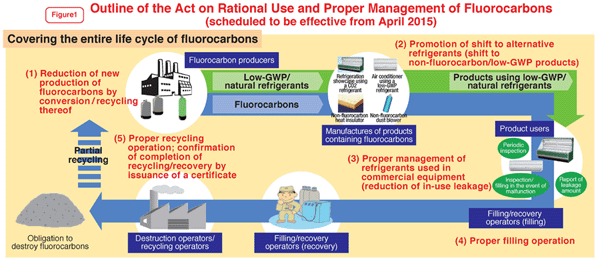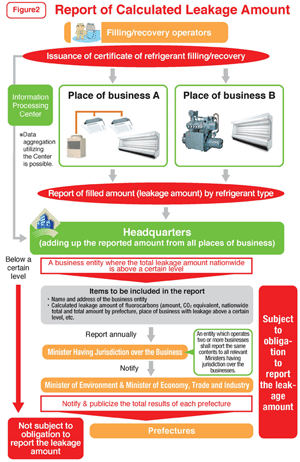Feature
Revision of the Fluorocarbons Law

An advanced usage example of a natural refrigerant: refrigeration showcase in Shibuya Hikarie ShinQs.
Natural refrigerants are refrigerants that use naturally occurring substances, mainly ammonia, CO2, water, air, hydrocarbons, etc., instead of fluorocarbons that have a high greenhouse effect.
In order to further strengthen the emission control of fluorocarbons that cause ozone depletion and global warming, the Fluorocarbons Recovery and Destruction Law was revised in June 2013 and will be put in force from April 1, 2015.
This revision is intended to provide measures to promote efforts towards emission control over the entire life cycle of fluorocarbons by significantly expanding the scope of regulation from the existing framework that ensures proper treatment of used fluorocarbons through their recovery and destruction. Therefore the name of the law has also been changed to "the Act on Rational Use and Proper Management of Fluorocarbons."
Background to the Revision of the Fluorocarbons Law - Fluorocarbons Control as a Central Issue in Tackling Global Warming -
Fluorocarbons are substances that are utilized for various operations such as refrigerants in air conditioners and refrigerators or foaming agents for heat insulators because they are chemically very stable, easy to handle, and less toxic and thus deeply-rooted in our everyday lives.
The production and import of ozone-depleting chlorofluorocarbons (CFCs) and hydrochloro-fluorocarbons (HCFCs) are restricted under the Montreal Protocol on Substances that Deplete the Ozone Layer, and their production in the developed countries is scheduled to be completely abolished in 2020.
On the other hand, the emissions of hydrofluoro-carbons (HFCs), non-ozone-depleting substances, have been on the increase as a result of rapid shift from ozone-depleting CFCs and HCFCs to HFCs. Moreover, it has been revealed that the amount of HFCs emissions is expected to be more than double the current amount in 2020 unless additional measures are taken.
Furthermore, while fluorocarbon emissions have increased, the government's existing framework and efforts for fluorocarbons control have turned out to be insufficient.
Under such circumstances, the Central Environment Council made recommendations to the Minister of the Environment that a comprehensive review of fluorocarbons control measures was needed. The Ministry of the Environment and the Ministry of Economy, Trade and Industry jointly submitted a bill for the revision of the Fluorocarbons Law to the Cabinet in 2013, which was enacted and promulgated in June of the same year (See Figure 1).
Outline of the Revised Law - Emission Control over the Entire Life Cycle of Fluorocarbons
The revised Fluorocarbons Law intends to strengthen the measures for emission reduction by promoting fluorocarbon-free in designated products and fluorocarbon substitutes which have lower greenhouse effect. This approach to focus on manufacturing process is very significant as a long-term and fundamental measure which aims for a fluorocarbon-free society.
Also, other big features in the Revised Law are the short- and mid-term measures as described in the following two new efforts aimed at promoting proper management of fluorocarbons refrigerants for commercial refrigerating/air conditioning equipment that are already commonly-used, and at preventing in-use leakage.
- Formulation and publication of criteria for judgment concerning measures that should be taken by users of commercial refrigerating and air conditioning equipment
- The publication system for reporting on calculated fluorocarbon leakage amount (see Figure 2)
Conclusion
Global warming is a threat that has a serious impact on the global environment, and fluorocarbons control is a very crucial part of global warming mitigation measures. We will therefore continue our efforts to ensure that the new obligations under the Revised Law are performed properly.




